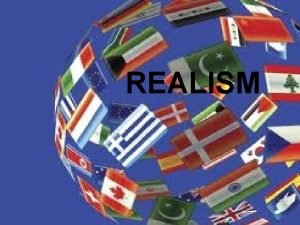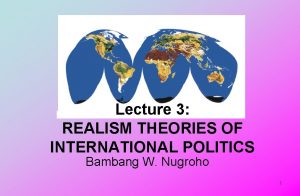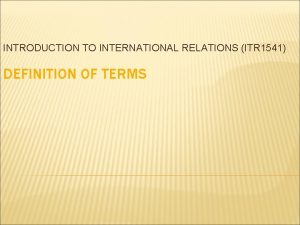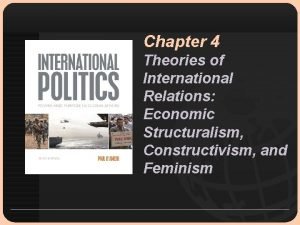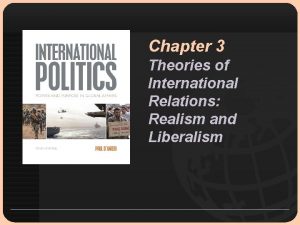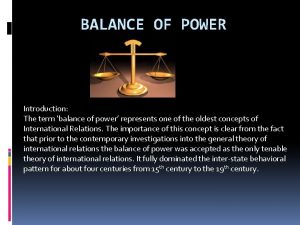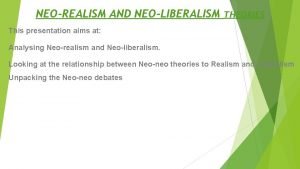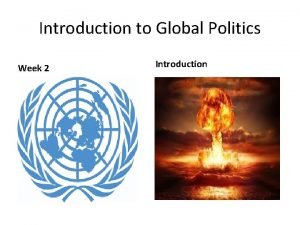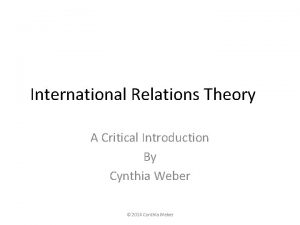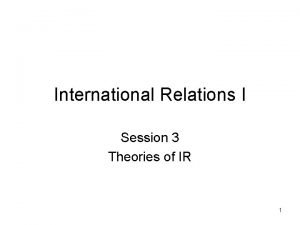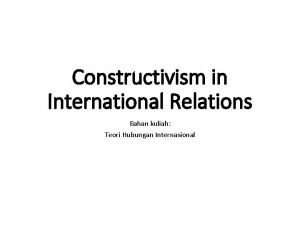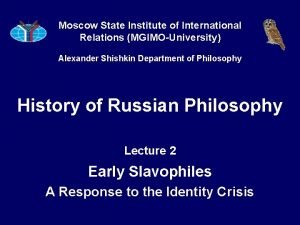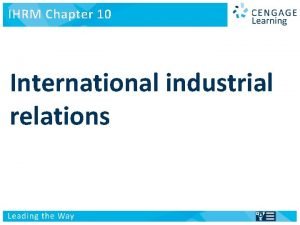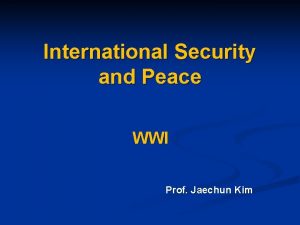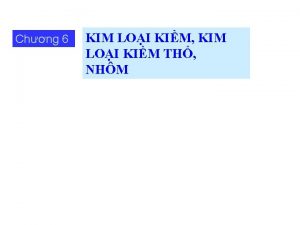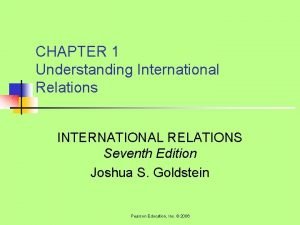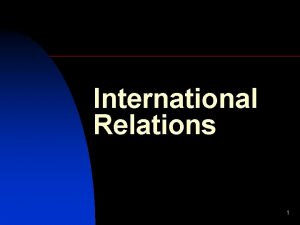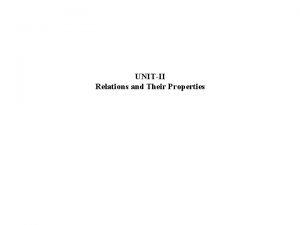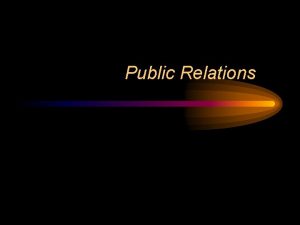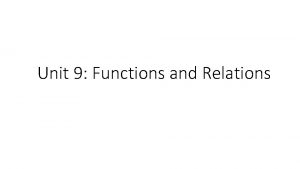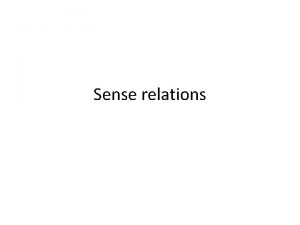Alliance in International Relations Prof Jaechun Kim Alliance




















- Slides: 20

Alliance in International Relations Prof. Jaechun Kim

Alliance in IR v Importance of Alliance in International Relations § v Important element of statecraft Alliance politics has been a common practice in IR § Weak states enter into alliance agreements, when they need protection against strong states. § Strong states form alliances to counter other strong states (to maintain proper balance of power).

Alliance in IR § Therefore, alliance has been a very important subject of research in IR

Defining Alliance v Coalition – “a set of members acting in concert at x time regarding 1 to n issues” (Fedder 1968: 80); Alliances are formed in peace time and coalitions are often found during times of war or crises (Snyder 1990: 106). e. g. , Coalition of the Gulf War in 1993, Coalition of the Willing in 2003 v Alignment – occurs when states bring their policies into close cooperation with other states in order to achieve mutual security (or foreign policy) goals. § Formal alliances strengthen existing alignments or create new ones. § Alliances are subsets of the broader phenomena known as alignments (Snyder 1990: 105).

Defining Alliance v Entente – more flexible association between states (Kann 1976: 611) No firm commitments exist between partners § Simple recognition of the fact that cooperation between them will make sense… cf. Triple Entente before WWI § v Coalition < Alliance < Alignment cf. Entente v Some do use them interchangeably

Theory of Alliance (Formation) v REALIST v Balance THEORY OF ALLIANCE of Power Theory (K. Waltz 1976) States balance against power – “power” is the most important variable § States tend to balance against stronger states § This is to ensure that no one states will dominate the intl system maintenance of balance of power §

Theory of Alliance (Formation) § Two types of balancing • • Internal balancing External balancing – alliance! § Internal balancing is more reliable… ; Alliance is the product of compromise between states § Why not balancing against the US? (Although K. Waltz claimed that the US would be eventually balanced by one or more states… )

Theory of Alliance (Formation) § Bipolar Stability vs. Danger of Multipolarity (K. Waltz) • Alliance pattern is unstable under the multipolarity • Buck-passing and Chain-ganging

v Balance 1987) of Threat Theory (S. Walt § Refinement of Waltzian BOP Theory § Walt adopts Waltzian neorealist framework and agrees that Waltz’s theory is sound, but not sufficient… § States tend to balance against threats rather than against power… power

§ Level of external threats is a function of four factors • • Distribution of capabilities Geographic proximity Offensive capabilities Perceived aggression intentions (S. Walt 1987: 22) perception is the key (constructivism? ) When states don’t feel threatened, they do bandwagon with the strongest state rather than balance against it…! e. g. , Bandwagoning with the US in the post Cold War era § Nonetheless, balancing is far more common than bandwagoning… §

v R. Scheweller (1994) – Balance of Interests § Balancing and bandwagoning are not opposite strategies; states choose them for different reasons! § Balancing is for self-preservation, while bandwagoning is for self-extension (balancing is driven by the desire to avoid losses, while bandwagoning is driven by the opportunity for gains (interests)) interests

§ States bandwagon with the stronger side because (or when) it represents the “wave of the future. ” § The presence of a significant external threat is not necessary for states to bandwagon; alliance choices are often motivated by opportunities for gain as well as danger! § The most important determination of alliance decisions is the compatibility of political goals (in IR), not imbalances of power or threat.

v Status-quo countries vs. revisionist countries § Satisfied powers will join the status-quo coalition(alliance), even when it is the stronger side § Dissatisfied powers, motivated by opportunities more than security, will bandwagon with an ascending revisionist state!

v Two types of bandwagoning § Jackal bandwagoning – ascent of powerful revisionist states or coalition attracts opportunistic revisionist states… § Piling-on bandwagoning – status-quo countries bandwagon with the strongest status -quo state or coalition v Bottom Line – “interests (i. e. , gains)” is an important element of alliance behavior

v Glenn Snyder (1984) – Alliance Security Dilemma § Security dilemma functions within alliances § 2 risks of alliance security dilemma • Risk of abandonment – danger that an ally does not come in help • Risk of entrapment – danger of being dragged into a conflict that alliance partner gets involved in (though that conflict is not in the interests of your country)

§ § Dilemma ! § if a state tries to reduce a risk of abandonment by increasing its alliance commitments, it ends up increasing a risk of entrapment § if a state tries to reduce a risk of entrapment by decreasing its commitments, it ends up increasing a risk of abandonment Alliance security dilemma is more severe in a multipolar than in a bipolar system. Why? (because there a number of plausible realignment options!)

v J. Morrow (1993) – Autonomy-security trade-off model Minor states get security benefits from their major alliance partners at the cost of sacrificing autonomy § Major alliance partners get autonomy benefits at the cost of providing security § Autonomy Security Source: Morrow (1991: 914)

Alliance Transformation in the post-Cold War Era v Realism – if common threats cease to exist, so will the alliance! § Predicted that the Cold War alliances would fall apart § Nonetheless, most of the US Cold War alliances survived the collapse of the Cold War order

v Liberal institutionalists – alliance is an institution! § Alliance takes on a life of its own, adapts to a new environment, and adopts new missions! § e. g. , NATO developed a host of institutional assets that are not just specific to the Soviet threats but general enough to tackle many post-CW security problems!

v Constructivists – identities and values are as much important as threat perceptions! § NATO allies grew to acquire similar values and sense of wefeeling that became the source of durability for alliance partnership. v Case Study: Why do the US Cold War alliances endure in Asia? ; How can we explain the longevity of NATO?
 Employee relations in public relations
Employee relations in public relations Realism nature
Realism nature Realist theory of international relations
Realist theory of international relations Balance of power in international relations
Balance of power in international relations Examples of international relations
Examples of international relations Comparative theories politics a level
Comparative theories politics a level Constructivism in ir
Constructivism in ir Economic structuralism theory
Economic structuralism theory Realist theory of international relations
Realist theory of international relations Balance of power in international relations
Balance of power in international relations Neorealism in international relations
Neorealism in international relations Cobweb model international relations
Cobweb model international relations Cynthia weber international relations theory
Cynthia weber international relations theory Dime framework
Dime framework Politics and international relations bath
Politics and international relations bath Neorealism international relations
Neorealism international relations Constructivism theory in international relations
Constructivism theory in international relations Reading international investor relations
Reading international investor relations Lomonosov moscow state university international relations
Lomonosov moscow state university international relations History of international relations
History of international relations International industrial relations in ihrm
International industrial relations in ihrm

